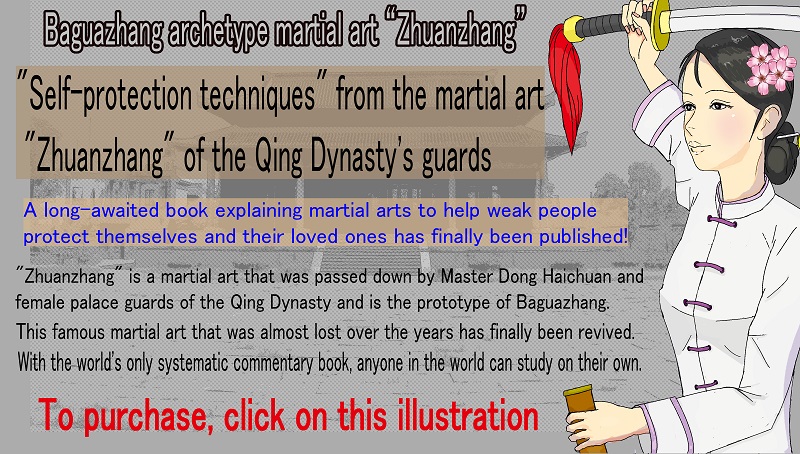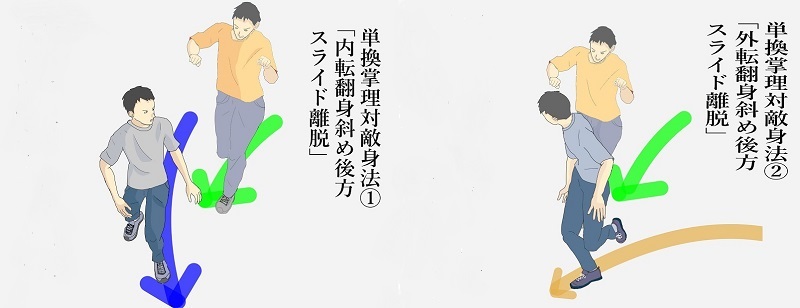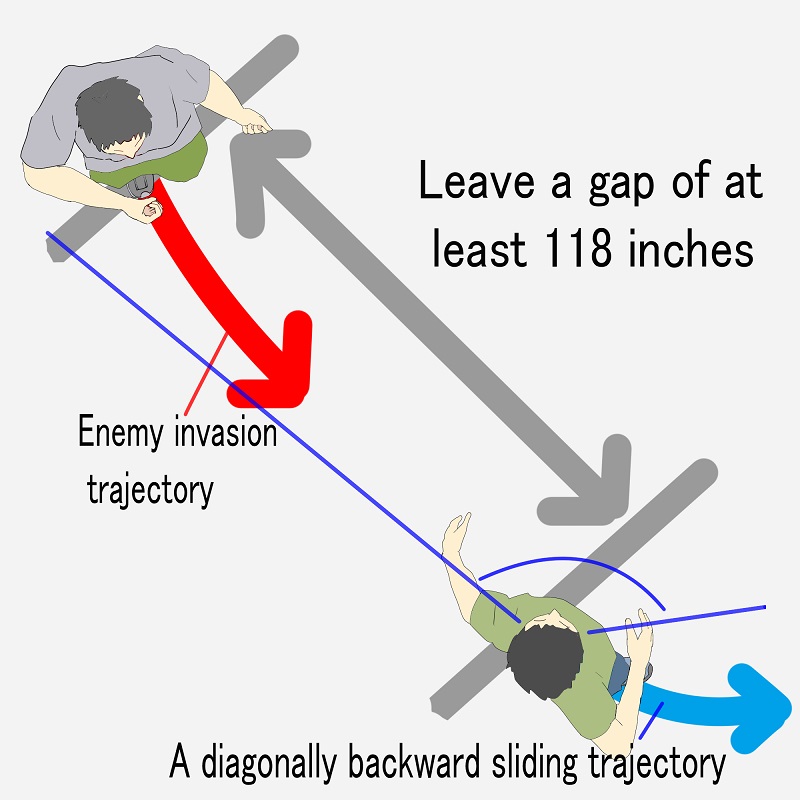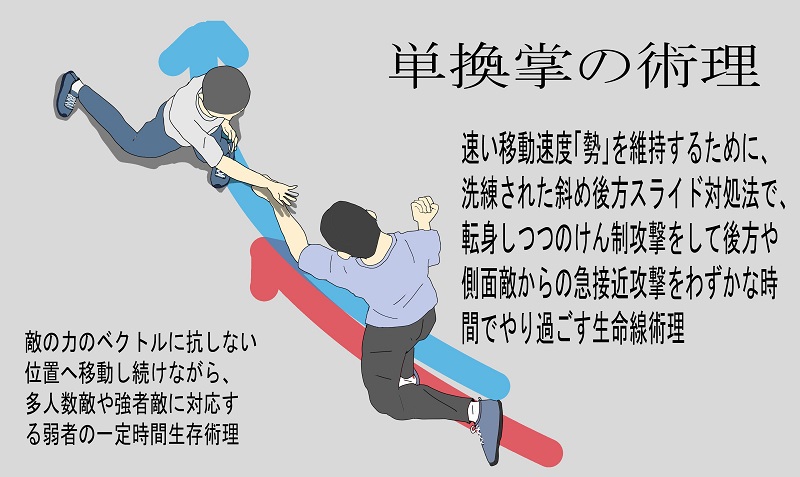Modern martial arts, including modern Baguazhang, consistently adopt a style in which force is clashed with the enemy.Therefore, this fighting method cannot be directly applied to self-defense of the weak.
"Zhuanzhang Style Baguazhang," which is intended for use by the weak, has a unique fighting style that is completely different from modern martial arts.
I've summarized them here into five points. Please consider them carefully and approach your practice accordingly.
- golden rules 1:First of all, discard the common sense of facing an enemy that has been instilled in you from TV martial arts matches and movies: "Face the enemy and get into a stance."
- golden rules 2:Anyway, keep your distance. Maintaining distance is the absolute basis of self-defense when fighting multiple people, a strong opponent, or a weapon.
- golden rules 3:Not only defense, but even attacks must be performed by "sliding diagonally backwards" to maintain a "deterrent retreat." You don't have to hit it. Just don't get hit.
- golden rules 4:Use "mobile warfare" to torment the enemy, and when they stop moving, retreat kilometres at a time.Build up the stamina to do so.
- golden rules 5:Since the legs are always used for moving defense and attack, there is no time to use kicking techniques, so there is no need to practice them.
- Supplementary principles:Learn the art of sword-based stick manipulation, and in times of emergency, you will be able to use the stick around you to fight back. Without practice, there is no possibility.

golden rules 1:First of all, discard the common sense of facing an enemy that has been instilled in you from TV martial arts matches and movies: "Face the enemy and get into a stance."
Don't be defensive. Don't face the enemy.The moment you take a stance, you are frozen in place and unable to react to your enemy's onslaught.
The only time you take a stance and fight is in a "match" where your opponent is the same weight as you and is under the control of a referee.If they are the same weight, they can withstand a brute force attack to a certain extent.It is extremely dangerous to become unable to endure and be pushed back and attacked unilaterally.Martial arts involve greater risk to life than other sports such as ball games, but there is always a referee to stop the match.However, in a situation where you use self-defense techniques, there are no judges.The other person will attack mercilessly to satisfy their desires.
You need to realize that the "common sense" that "When the enemy shows an intention to attack, first face them, prepare to attack, and see what happens..." limits the options you can take.You are limiting yourself to the worst possible option, which is to defend yourself by colliding with a strong person's brute force attack.If you stay in place, prepared to attack, you will not be able to choose the option of moving diagonally backward to defend yourself, which would not oppose the enemy's force.
Without being ready, move as if fleeing, keeping the enemy diagonally behind you, and maintain some distance.By starting to move yourself, you prevent yourself from "settling" in place.When the enemy shows their intention to attack and closes the distance, there's no need to hesitate.Start retreating diagonally behind you at high speed, putting at least two meters of distance in front of them.
It's not about "moving when the enemy starts to move," but rather, before the enemy starts to move, or the moment you think the enemy is going to move, it's important to move back quickly and quickly. If you slide backward after the enemy has moved, even a slight delay in reaction will allow the enemy's hand to reach you.
It is extremely dangerous to simply say not to make eye contact.However, if an enemy has moved so far back that they are completely out of sight, there is no need to turn around and keep looking at them.If you are steadily moving forward, the enemy's attacks won't hit you, and even if they do, they won't do much damage.And your own attacks won't hit them either.Therefore, there's no point in continuing to look.
This flow is the basic practice of late Zhuanzhang style Baguazhang.
When you are moving and an enemy comes into view, move diagonally backward while glancing briefly out of the corner of your eye.This is the "Danhuanzhang" movement.
In practice, you move with your head facing straight, and when you imagine an enemy coming into view, you respond with a Danhuanzhang.
To practice your posture when moving, keep your hands down and relaxed, maintaining a posture and state that allows you to quickly step back and put your hands out if necessary.This is the "basic stance".
golden rules 2:Anyway, keep your distance. Maintaining distance is the absolute basis of self-defense when fighting multiple people, a strong opponent, or a weapon.
The importance of keeping distance
First, the top priority is to acquire the skills to avoid contact with enemy attacks.In other words, the top priority should be to master the technique of "when the enemy charges, stepping back diagonally without slowing down."
First, you need to get rid of the idea of "defending with manual techniques."Introductory videos and images for self-defense classes often show women using hand techniques to defend themselves against attacks by the instructor.They are impossibly and beautifully done.
Thanks to those images and videos, the concept of "defending with technique" has been ingrained in the minds of most women who are interested in self-defense.One thing we must not forget: it is a "promised kumite" based on mutual agreement. It is not a real fight.
"But Sensei, if I step back, I'll be caught up from behind. I can't do something so scary."」
However, if you don't step back, you'll be instantly overwhelmed by a brute force attack.It's scary enough to have to block an enemy attack in place without backing down.And because there is no way to escape, the chances of survival or self-defense are virtually nonexistent.

This is a problem of the image of actual combat. Many people who learn self-defense techniques have never experienced an unreasonable attack from an enemy in real combat, so they assume that videos like that are the same as real combat.At the very least, the mock videos in self-defense classes are not actual combat. I repeat, they only show prearranged sparring.
In the first place, how many people can accept the enemy's irrational attack as reality at that time?There is a big difference in how well people can change their mindset when an emergency occurs between those who practice on a daily basis with the expectation that a real battle will occur and those who do not.
This is why you are left standing there helpless as an enemy charges at you, attacking you unilaterally.This is exactly the same for people who regularly practice martial arts.
As mentioned in Rule 1, if you sense hostility, just slide diagonally backward without thinking. It's okay if it's a misjudgment. It's okay if the other person doesn't want to do it.
At my workplace, the threat of wild animals was a real threat. To protect myself from wild animals (wild boars), if I sense a wild boar, I don't think twice and move a long distance away from the area. In most cases, they won't come towards me. However, on rare occasions, a wild boar will come towards me. I have always trained myself to leave the area as soon as I sense the presence of a wild boar, so even though most of my evasive actions are futile, I was able to carry them out confidently each time, which protected me in the event of an emergency.
"Diagonal backward slide" to create distance
When we teach self-defense at our school, we always emphasize that the only life-saving techniques mentioned above are to "keep your distance from the enemy and avoid contact with the enemy."The technique for this is the two "retreat slides" that are the core techniques of the Zhuanzhang Style Baguazhang (see illustration).
This is very important. In the martial arts of old, when fighting with bladed weapons was the norm, "defense" meant "keeping distance."
In fact, according to a senior apprentice who actually studied and practiced Japanese swordsmanship, the normal distance between swordsmen in the old days was 5 to 10 meters. Otherwise, no matter how hard you tried to defend yourself, the edge of the blade would eventually touch and result in a fatal injury.
At our school, we also aim to maintain a distance of at least 3 meters.
If you are far away from the enemy, you don't need much skill in the technique.The only important technique is to put your hands out in front of you and immediately slide diagonally backward when the enemy approaches (you don't necessarily need to put your hands out once you get used to it).

golden rules 3:Not only defense, but even attacks must be performed by "sliding diagonally backwards" to maintain a "deterrent retreat." You don't have to hit it. Just don't get hit.
By sliding diagonally backwards, the team aims to avoid being hit.
The principle of self-defense for the weak, taught in the original martial art of Baguazhang, "Zhuanzhang," does not call for putting oneself in danger even when attacking.In other words, even attacks must be carried out while stepping back.
Even during interpersonal training at Suishikikan, we repeatedly practice attacking while stepping back.In other words, the offensive technique you will learn will be "retreat battle."
The opinion that "If I attack while stepping back, my attack won't reach the enemy!" is the opinion of someone who has never faced self-defense techniques in a situation where they were threatened by a strong opponent and their life was in danger.
Self-defense techniques are not techniques for defeating the enemy, but techniques for protecting oneself. Defeating an enemy is merely one means of protecting oneself from the enemy, and is not the goal. The goal is, above all, to "survive."
To put it frankly, "It doesn't matter if it doesn't hit. As long as it doesn't hit, that's fine."
The Zhuanzhang Baguazhang was a martial art used by eunuch guards who performed decoy escort duties by engaging in thorough mobile combat and "surviving" for a certain period of time. The technique of "surviving" for a set period of time can still be used as an effective "self-defense technique" in modern times.
In order to defeat an enemy, you must get within the enemy's attack range and land your attack on them. If you get within the enemy's attack range, the moment you step forward, you will naturally be inside the enemy's range and be hit by an attack. In other words, the method of "defeating" was a dangerous "lower-level measure" that posed a risk to the objective of "survival."
The end of the Qing dynasty was a turbulent time when even common people were at risk of losing their lives in their daily lives. Rather than the skill of hitting the enemy and defeating them, the "best strategy" to directly ensure survival was to hone the skill of avoiding being hit by the enemy's attacks (the skill of keeping distance).

The purpose of Zhuanzhang Style Baguazhang and modern martial arts Baguazhang is different.
In modern Baguazhang, you slide sideways to avoid defenses, but move forward when attacking. The main goal is to land an attack, inflict damage on the opponent, and defeat them. And because it is no longer a self-defense technique, the "purpose" has become to defeat the enemy and demonstrate the strength of one's school.
At the transition point from defense to counterattack, techniques (spiral force and internal force) are required to negate the power of a strong enemy. These delicate techniques are also techniques for directly facing off against attacks from a strong opponent, so they require extensive repetition in interpersonal training against a strong opponent. Securing a training environment is difficult, and these are typical techniques that "depend on the opponent."
As the enemy charges, keep moving with a diagonal backward slide, and when they force their way into your range, put out your hand, or use the diagonal backward slide movement technique, or hit them with a tool you have on hand to stop their feet. Always keep this general flow in mind as you practice.
golden rules 4:Use "mobile warfare" to torment the enemy, and when they stop moving, retreat kilometres at a time.Build up the stamina to do so.
弱In order for the weak to achieve self-defense, they must stick to mobile combat from start to finish and not resist the enemy.
The basics of self-defense are to attack first and then flee when the enemy flinches. Or, just flee. I often come across self-defense instruction websites that tout such unrealistic methods.
There is a big danger in attacking first and then running away: it is almost impossible to inflict damage with a preemptive attack.
If you launch a preemptive attack, you will leave your body completely in front of the enemy. If you fail, you have no choice but to flee. However, leaving your body behind means that your body will become fixed in place. If you fail, you must move your body to a safe place before the enemy's attack arrives. However, even for an experienced player, it is a difficult technique to go from being fixed in place to moving quickly.
Why do all martial arts and self-defense techniques place such emphasis on the preemptive attack? When it comes to creating an opportunity to escape, why do we insist on attacking and damaging the enemy, when this is a high-stakes method that has a high risk of failure and is dependent on the opponent, making it a gamble?This is because the martial arts they learned and used as references when teaching self-defense techniques are martial arts intended for use by strong people. They only customize them for superficial self-defense techniques, and therefore miss the essential aspects of self-defense for the weak.
So why is suddenly moving diagonally backward and engaging in mobile warfare not appreciated in modern times? This is because they have never experienced actual combat and therefore cannot imagine that it is difficult to launch a preemptive attack on the enemy. And secondly, people do not want to accept a battle that requires constant movement and getting out of breath.
The reason why people don't adopt mobile combat, even though they know how effective it is in overcoming battles against many opponents and strong opponents, is simply because they still can't accept the reality. On this page, you have come into contact with the realities of the battlefield of self-defense for the weak. It may have been shocking to you, but it must have also made sense to you. Which path will you take from now on?
In a retreat, use the unique combat principle of "Danhuanzhangli." At the end, make use of your endurance to escape.
If you think about it calmly, you will realize that you cannot escape by simply running away. "Zhuanzhang" understands this point well. Therefore, he left the technique of retreat as the most important basic technique.That is the "Danhuanzhangli(Essence of Single Palm Change)"
The enemy, with no rational brakes in place, will frantically pursue the fleeing person in order to realize his own desires.
Even in wars of old, the casualties of troops who lost the will to fight and simply fled without offering any resistance were extremely tragic.On the other hand, troops who set up ambushes and retreated while inflicting damage on pursuing enemies were able to minimize their losses.
In the Chuan Shang Baguazhang technique, the retreating maneuver of sliding diagonally backwards makes the enemy wary, slowing down the pursuit and creating an opportunity to retreat.The diversionary attack in the Danhuanzhang technique stops an onrushing enemy in their tracks.Using the endurance you have built up, you will repeat this deterrent attack many times (about 5 to 20 times).
This is where the efforts you've made to develop endurance pay off. Endurance is a dream area where, depending on your own efforts, you can make up for disadvantages due to age or gender.
Many people tend to avoid endurance competition, or efforts to improve endurance, because they think it is unexciting and requires patience. The effectiveness of improving endurance is particularly difficult to accept for those who believe that mastery lies in using magic-like physical manipulation to defeat an opponent without running out of breath.
When the enemy becomes out of breath, slows down, and is no longer able to react to your movements, you muster all your strength to survive and begin to withdrawhen you withdraw, you should withdraw by kilometers. If you are only a few meters away from the enemy, it will not be effective against a strong enemy (they will close the distance quickly). That is not withdrawal, it is simply "avoidance."
In the past, masters taught common people with no martial arts skills "fleeing techniques" and "training methods to build up the stamina to keep fleeing." Even "Zhuanzhang Style Baguazhang" will teach you these two things clearly.
golden rules 5:Since the legs are always used for moving defense and attack, there is no time to use kicking techniques, so there is no need to practice them.
In "Zhuanzhang Style Baguazhang", there is no need to practice kicking techniques. This is because you will not be using kicking techniques. To be precise, there is "no time to use kicking techniques."Because the legs are always used for "defense" - "moving while maintaining momentum" - there is no time to stop the legs for kicking techniques.
Take a look at the example of using the diagonal backward slide. In any case, from the perspective of "maintaining distance from the enemy by not slowing down (maintaining momentum)", we are committed to not using any techniques or movements that would hinder movement. In other words, you can see that no kicking techniques are used.
When performing a normal kicking technique, the axis of support for the body is created by the leg opposite the leg that is kicking.
When forming a body axis, the body is supported by the pivot leg, which means that the body temporarily stops in front of or to the side of the enemy, making it impossible to move (defend) for that moment.
In "Zhuanzhang Baguazhang," "stopping" means "death," and the body is abhorrent to stopping, as it becomes an "immobile target" for the enemy.
You can't waste your valuable practice time on kicking techniques that you won't use. There's no need to practice them.
Supplementary principles:Learn the art of sword-based stick manipulation, and in times of emergency, you will be able to use the stick around you to fight back. Without practice, there is no possibility.
身There are many self-defense dojos that teach the use of everyday objects in combat, but most of them focus on explaining extremely difficult and courageous techniques such as sweeping or entangling your hands to drop your weapon in interpersonal training.
The sword technique "Zhuanzhang Dao(Zhuanzhang Sword)" in Zhuanzhang Baguazhang is Basic form that embodies a method that allows someone with no martial arts background or physical strength to have a high chance of surviving a bladed attack from an assassination expert or someone who has lost their mind.These short, simple movements are meant to be ingrained in the body.It is a Basic form that includes methods for defending yourself with weapons and protecting important people.
The "Zhuanzhang Dao" technique is constructed using the same body manipulation techniques as the "Zhuanzhangshi," the main counter technique of the "Zhuanzhang Style Baguazhang". By practicing Zhuanzhang Dao, you will also hone your bare-handed techniques, creating a synergistic effect.
Once you have learned how to use the simplest possible form, you simply repeat it over and over until it becomes ingrained in your body. After that, by simply trying it out when practicing the Diagonal Backward Slide Counterattack, the movements will come out naturally in actual combat.
I am surprised at the number of practitioners who say, "Weapons are an extension of the hand," and deliberately avoid spending much time on them. If you have never taken the time to practice weaponry, your practice time is simply not enough. For those who do not have enough time, holding a weapon in their hands is nothing but a hindrance.
As a self-defense technique, it is natural to use objects around you, with bare hands being a last resort. In "Zhuanzhang Style Baguazhang", handling weapons is considered extremely natural and is a method that should be used whenever possible in combat. By practicing "Danhuanzhang" and Double "Shuanghuanzhang (Doublele Palm Change)" with some kind of weapon every day, the presence of the weapon will no longer hinder your movements, and you will be able to use it freely.

